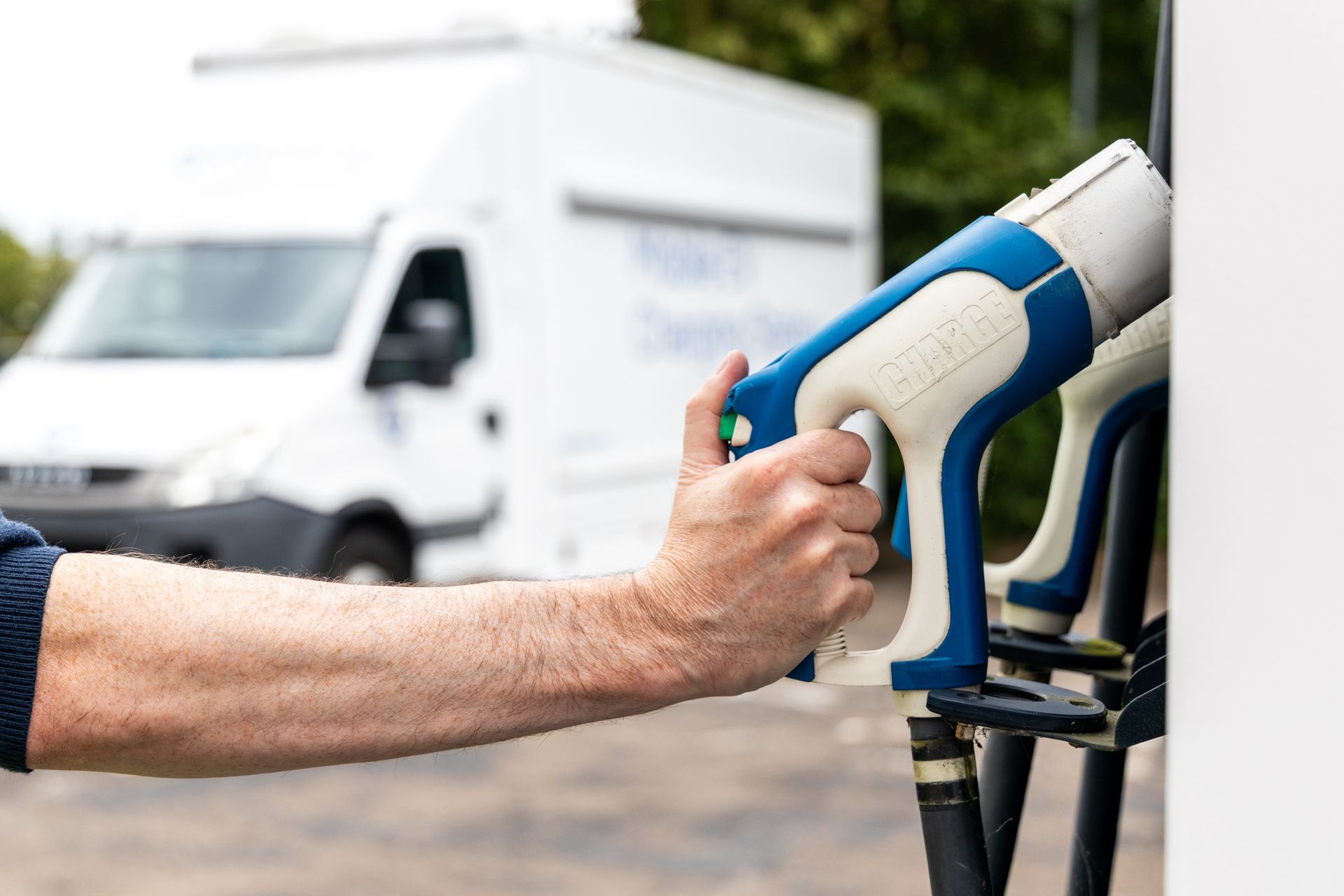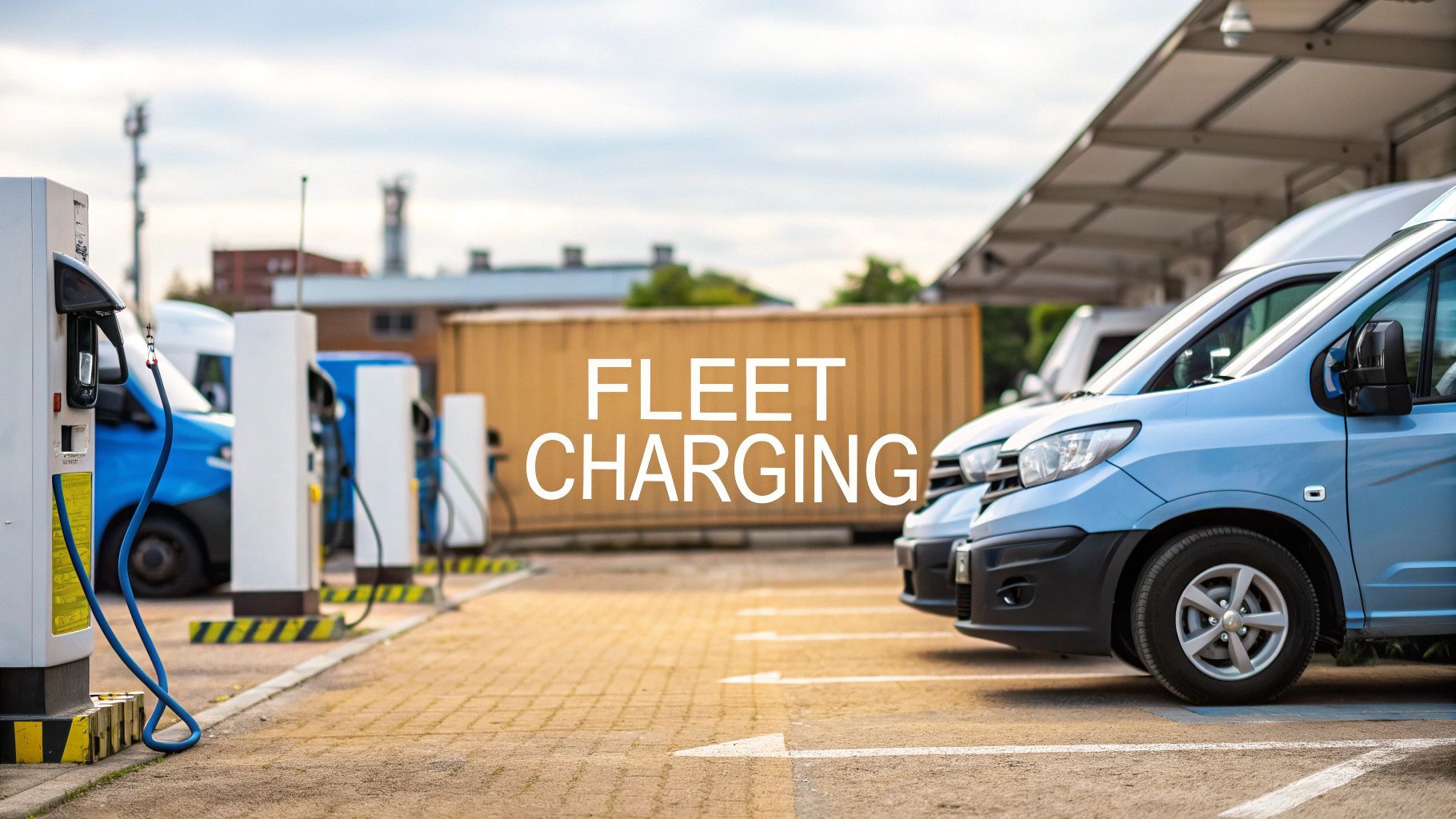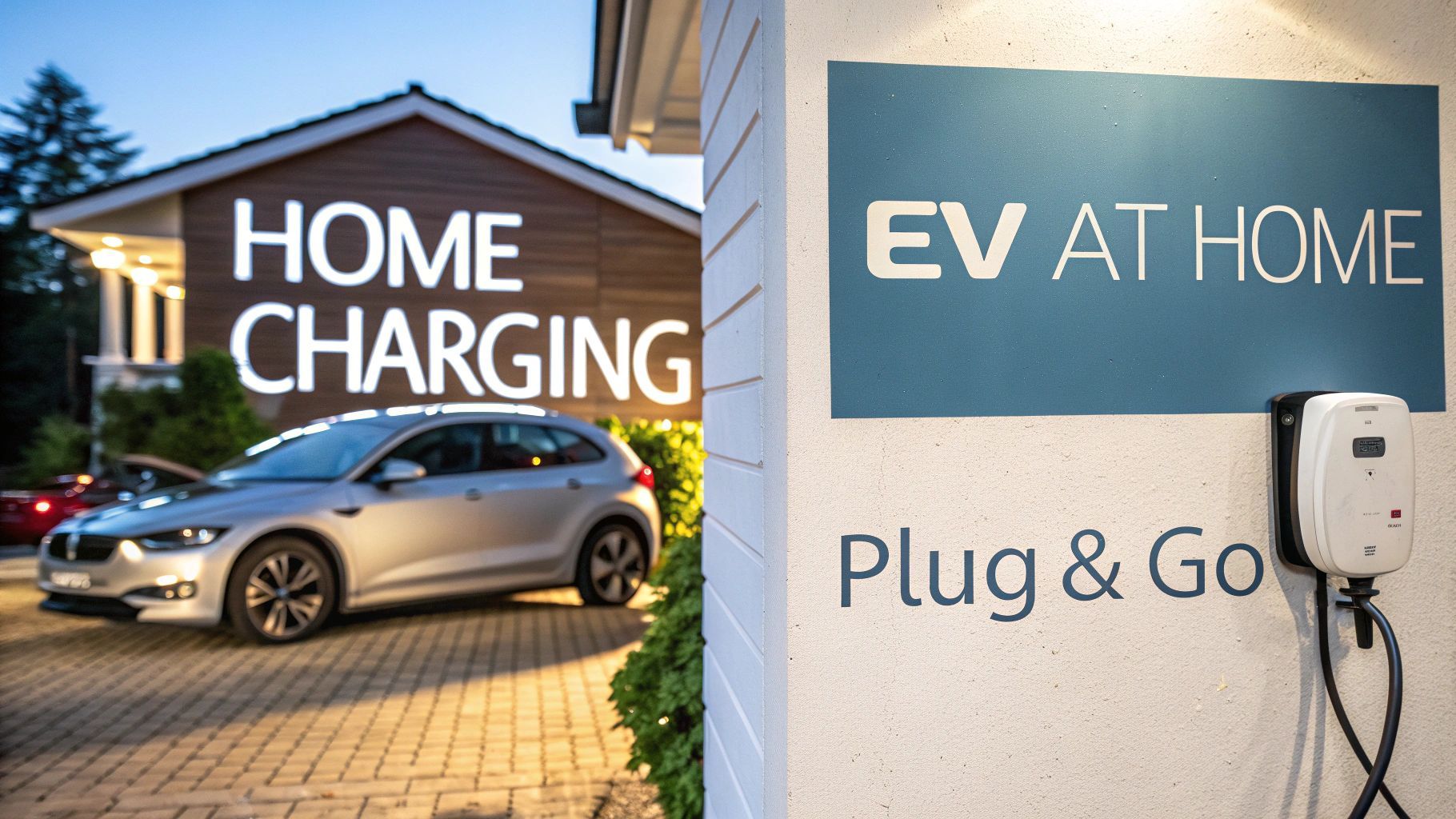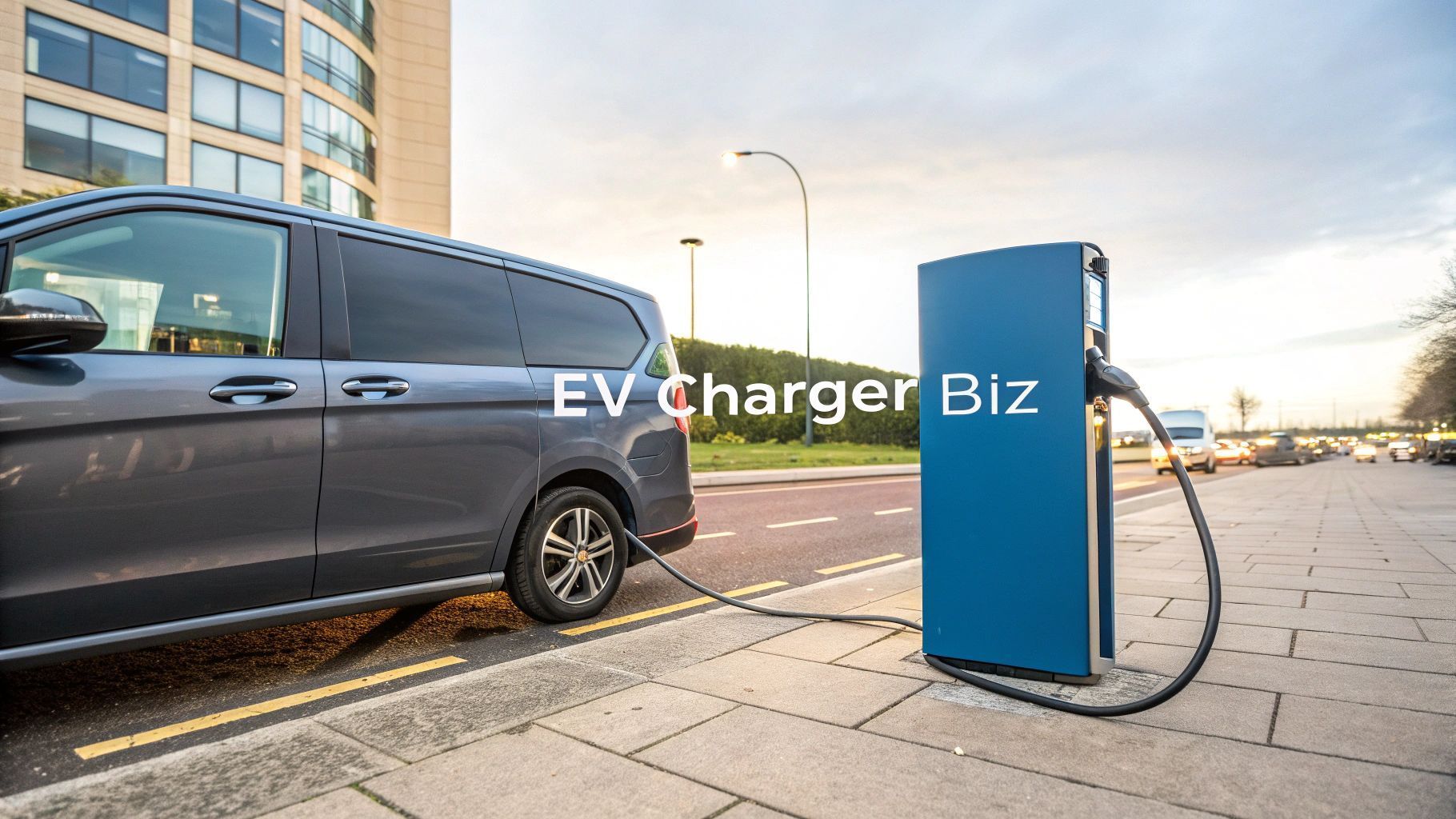Find the Best Electric Car Charger Adapter in the UK
Pulling up to a public charging point only to find the plug doesn’t fit your car is a uniquely frustrating part of EV ownership. This is exactly where an electric car charger adapter proves its worth. Think of it as a universal travel plug for your EV, bridging the gap between your car’s charging port and the mishmash of connectors you’ll find out in the wild.
This small, simple device is the key to unlocking true charging freedom.
Why Every EV Driver Needs a Charger Adapter
For any EV driver, the open road is the ultimate goal but that freedom hinges on one thing: being able to charge up reliably. The nagging worry about finding a compatible charger can easily turn a relaxing drive into a game of chance. An electric car charger adapter is designed to put an end to that stress.
It’s like the difference between carrying a proprietary phone charger that only works with one specific socket and having a universal USB-C cable. One severely limits your options, while the other opens up a world of convenience. An EV adapter works on the same principle, making sure you’re never locked out of a potential top-up just because the plug is different.
Navigating the Growing Charger Network
The UK’s charging infrastructure is growing at an incredible pace. As of early 2025, the country had 76,507 publicly available electric vehicle charging devices . This network is a real mix of technologies. Just over half ( 56% ) are slower chargers (from 3kW to 8kW ), while around 20% offer rapid charging at 50kW or more.
This diversity is fantastic for encouraging more people to switch to electric but it also creates complexity. Without the right adapter, a huge chunk of this expanding network is completely off-limits. This is a massive headache for drivers who rely on public chargers, especially those who cannot install one at home. You can read more about this challenge in our guide on how ZAPME supports drivers without home charging options.
Maximising Your EV's Potential
An electric car charger adapter is so much more than a bit of plastic and metal—it’s an investment in your peace of mind. It unlocks your vehicle’s full potential by tearing down the walls built by incompatible charging standards.
Owning an EV adapter completely changes how you plan your trips. Instead of mapping your route from one specific charger type to the next, you can simply head to your destination, confident you’ll have the flexibility to power up wherever you end up.
Ultimately, carrying the right adapter means fewer detours, less time spent waiting, and a much smoother ownership experience. To really get the full picture, it helps to understand the basics from a complete guide to EV charger installation , which gives context to the whole ecosystem. With this simple tool in your boot, long journeys in your EV become completely worry-free.
Understanding Different EV Connector Types
Jumping into the world of EV charging can feel a bit like learning a new language, complete with its own plugs and standards. Think back to when every mobile phone had a different charger before USB-C came along – the electric vehicle market is in a similar spot, with a few key connector types you need to know. Getting your head around these is the first step to understanding why an electric car charger adapter is such a game-changer.
In the UK, the charging landscape really boils down to a few key players. For your everyday AC top-ups at home or the supermarket, the Type 2 connector is king. But when you’re on the motorway and need a fast charge, you'll almost always be looking for either a CCS (Combined Charging System) or a CHAdeMO plug.
The UK Standard for AC Charging: Type 2
The Type 2 connector, sometimes called a Mennekes plug, is the undisputed champion of AC charging across the UK and Europe. If you are plugging in your EV at home, work, or in a public car park, this is the connector you will be using. Its clever seven-pin design can handle everything from slow single-phase power to faster three-phase charging, typically delivering up to 22kW .
Pretty much every new electric car sold in the UK and Europe today comes with a Type 2 inlet, which makes day-to-day charging simple. The need for an electric car charger adapter usually pops up when you come across an older public charge point or need to use a portable charger with a standard domestic socket.
Rapid DC Charging: CCS and CHAdeMO
When you need to add serious range and fast, you turn to DC rapid chargers. These powerhouses operate at much higher levels, anywhere from 50kW all the way up to 350kW . They work by bypassing your car's onboard converter and feeding power directly into the battery. In the UK, this is where you'll find two competing standards.
- CCS (Combined Charging System): As the name suggests, this plug cleverly combines a Type 2 AC connector with two large DC pins underneath. This design has become the go-to standard for most modern European, American, and Korean EVs, including brands like Volkswagen, BMW, Hyundai, and even the latest Tesla models. It's the dominant force in new rapid charging installations.
- CHAdeMO: This standard was developed in Japan and is what you'll find on vehicles like the Nissan Leaf and Mitsubishi Outlander PHEV. While it was once a strong contender, most new rapid chargers are now prioritising CCS. This shift makes a CHAdeMO to CCS electric car charger adapter a potential lifeline for owners of older compatible vehicles wanting to access the ever-growing network.
This image shows the main connector types and how adapters create a bridge between them.
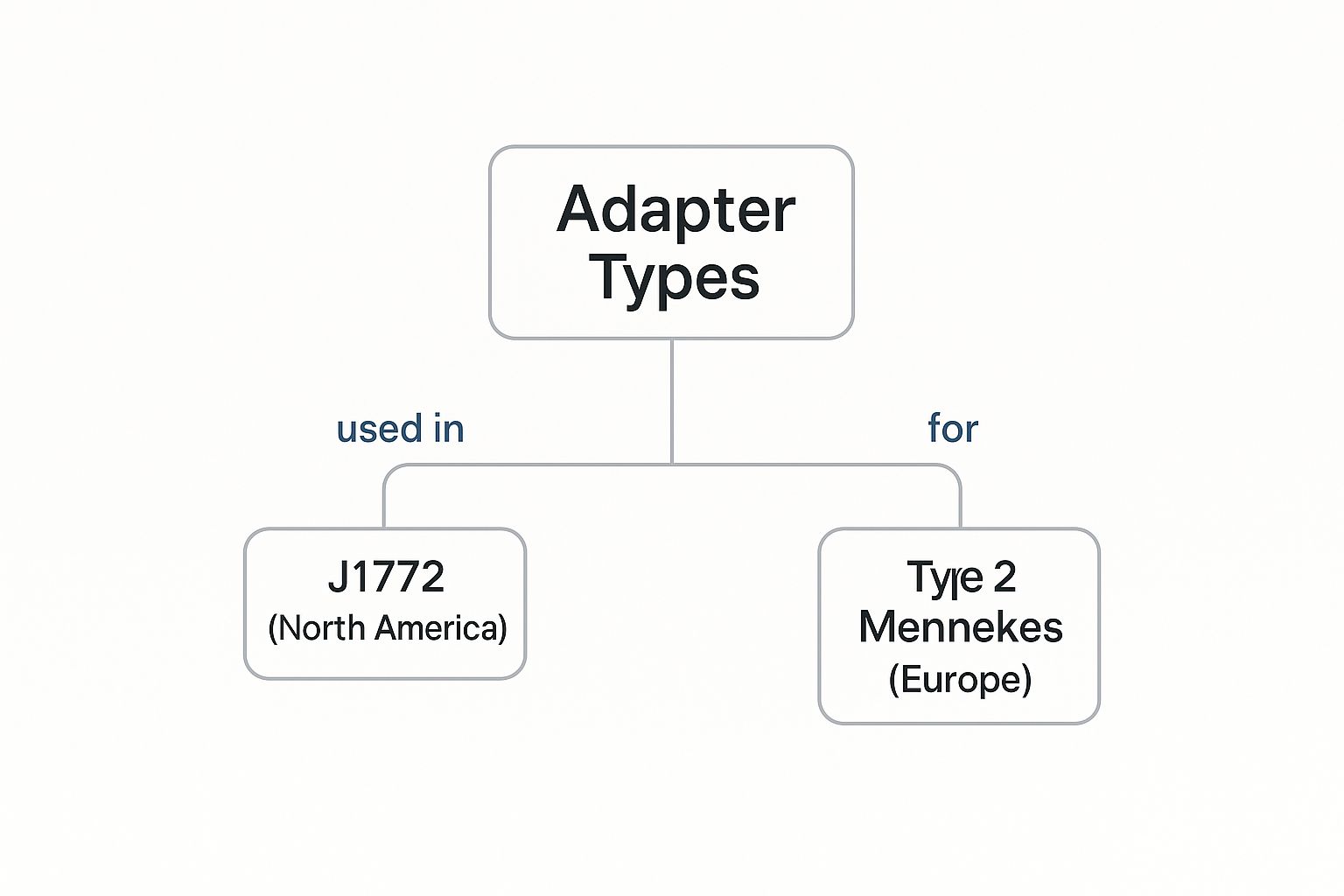
You can see how different regional standards, like the J1772 in North America and Type 2 in Europe, need adapters to work with widespread fast-charging systems like CCS.
The real challenge isn’t just the physical shape of the plug. It’s about communication. The car, the charger, and any adapter in between must all 'speak' the same digital language to safely manage the flow of high-power electricity.
Knowing these standards is crucial for any EV driver. It directly affects where you can charge and helps you figure out which electric car charger adapter you might need. To get a better handle on the different types and locations of chargers, this comprehensive guide to electric car charging stations is a great resource that explains charging levels and how to find stations.
UK Electric Car Charger Connectors at a Glance
To make things clearer, here’s a quick breakdown of the connectors you'll find across the UK.
| Connector Type | Typical Use (AC/DC) | Common Power Output | Example Car Brands |
|---|---|---|---|
| Type 2 | AC | 3.7kW - 22kW | Most European & UK EVs |
| CCS (Combo 2) | DC | 50kW - 350kW | VW, Audi, BMW, Hyundai, Kia, Tesla |
| CHAdeMO | DC | 50kW - 100kW | Nissan, Mitsubishi |
This variety is exactly why having the right adapter in your boot can make or break a long journey. As the UK's charging network continues to grow and change, having the tools to navigate its diverse hardware means you’ll never be left stranded. You can learn more about which chargers work with which cars by checking out our guide on EV charging compatibility.
How to Choose the Right Charger Adapter
Picking the right electric car charger adapter is about so much more than just matching plug shapes. It’s a decision that directly affects your charging speed, the health of your car's battery, and most importantly, your safety. A cheap, poorly made adapter will not just fail to charge your EV—it could cause permanent damage to your battery or charging port.
This guide will walk you through the essential factors, making sure you can make a confident and safe choice.
The first, most fundamental step is to confirm compatibility. You need to be certain the adapter physically connects your car’s charging inlet to the charging stations you plan to use. For example, if you own an older Nissan Leaf with a CHAdeMO port but want to tap into the growing network of CCS rapid chargers, you'll need a specific CHAdeMO-to-CCS adapter.
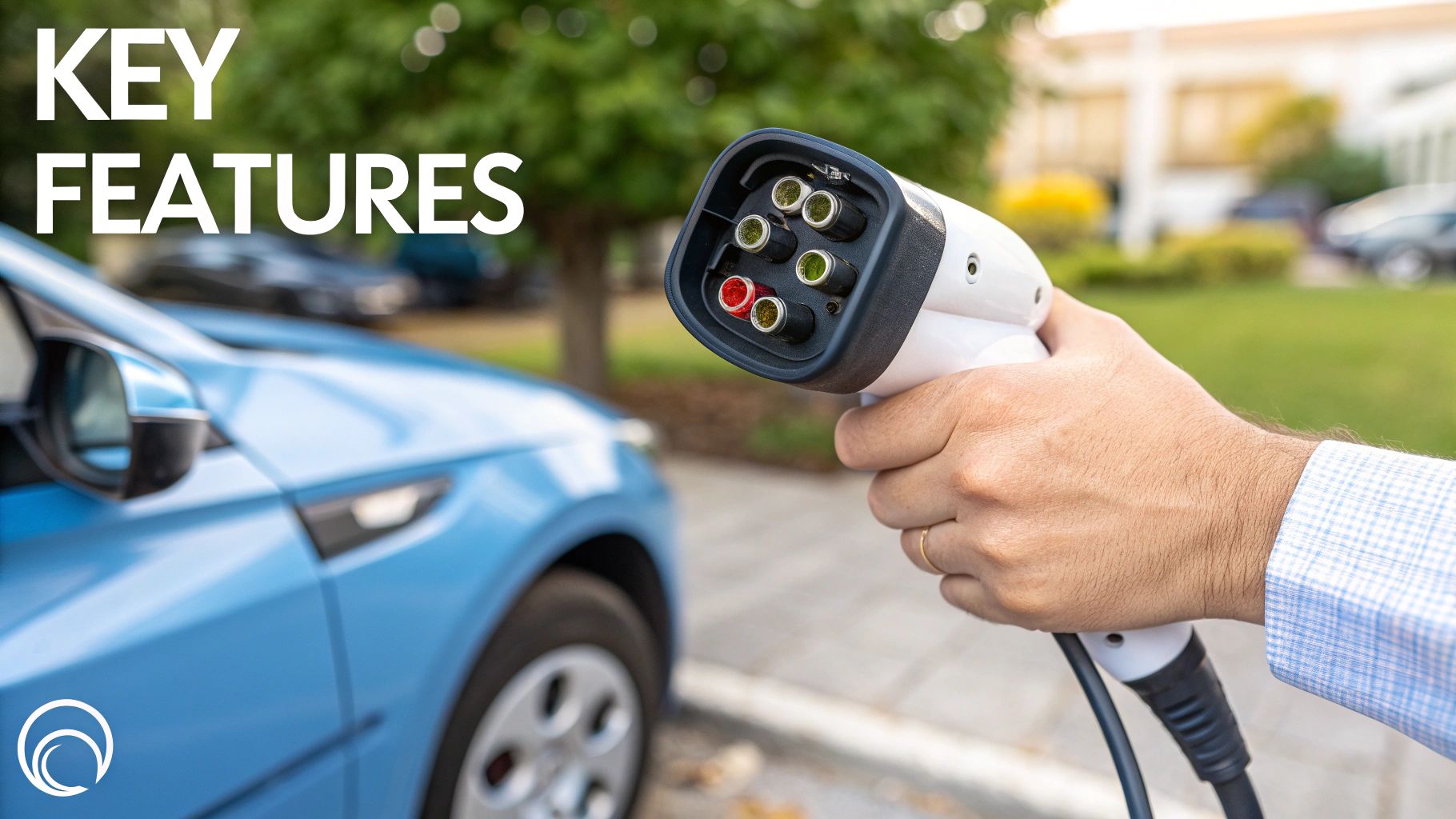
Check the Power Rating
Beyond the physical fit, the adapter's power rating is arguably the most critical detail. Every adapter is rated for a maximum power level, measured in kilowatts (kW), that it can safely handle. Using an adapter with a lower rating than the charging station's output is asking for trouble.
Think of it like trying to funnel water from a fire hose through a narrow garden hose. The pressure would be far too much and the hose would likely burst. In the same way, forcing 150kW from a rapid charger through an adapter only rated for 50kW can cause it to overheat, melt, or even catch fire.
An underrated adapter is not just a safety risk; it will also throttle your charging speed. Your car and the charger will communicate and automatically slow the power flow down to the adapter's maximum limit. That means you’ll spend far longer tethered to the station than you need to be. Always choose an adapter with a power rating that matches or exceeds the charging speeds you expect to use.
Prioritise Safety Certifications
In the UK and Europe, the CE marking is a non-negotiable stamp of approval. It is a crucial indicator that a product meets essential health, safety, and environmental protection standards. When you are buying an electric car charger adapter, this should be the first thing you look for.
Uncertified adapters, often found on online marketplaces at tempting prices, are a huge gamble. These cheap knock-offs frequently cut corners, skipping vital safety features like temperature sensors and proper insulation. This can lead to overheating that damages your vehicle’s sensitive electronics, potentially landing you with a repair bill that runs into the thousands.
A certified adapter ensures:
- Proper Insulation: Protects against electric shock and prevents short circuits.
- Overheating Protection: Internal sensors monitor temperatures and will cut the power if things get too hot.
- Durable Materials: It’s built to withstand repeated use and exposure to the elements without falling apart.
Consider Build Quality and Weatherproofing
Your adapter is going to live a tough life, likely being used outdoors in all kinds of British weather, from pouring rain to freezing cold. Look for products with a solid Ingress Protection (IP) rating, like IP54 or higher. This number tells you how resistant it is to dust and water splashes, ensuring it stays safe and functional for the long haul.
A well-built adapter will feel sturdy in your hands and have secure locking mechanisms that click firmly into place. Flimsy connections can lead to intermittent charging or, even worse, dangerous electrical arcing.
For a reliable selection of tested products, you can explore the options in our collection of ZAPME EV charging accessories. Investing in a high-quality, certified, and properly rated adapter is a small price to pay for the safety of your vehicle and your own peace of mind.
The Rise of Mobile EV Charging Businesses
Ever thought you could turn a stranded electric vehicle into a genuine business opportunity? That's the new reality being shaped by mobile EV charging, where savvy entrepreneurs use powerful, often van-mounted chargers to deliver electricity right where it is needed. It is a fundamental shift away from relying on fixed charging points, carving out a profitable niche in the UK's booming EV market. The key advantage is providing an on-demand service that fixed infrastructure simply cannot match, offering unparalleled convenience to drivers and a lucrative revenue stream for operators.
With more EVs hitting UK roads every month, the demand for flexible and accessible charging is only growing. Mobile charging operators are perfectly placed to fill the gaps left by the traditional network, turning so-called charging deserts into profitable service areas. This flexibility means an operator can go where the demand is, from city centres during the day to residential areas in the evening, maximising their earning potential.
The uneven spread of public chargers creates some obvious opportunities. Right now, the UK's charging infrastructure is heavily skewed, with Greater London completely dominating the map. By July 2025, the capital was home to over 25,502 public EV charging devices , which is around 30% of all chargers in the country —more than double any other region. At the other end of the scale, Northern Ireland’s figure of just 35 chargers per 100,000 people paints a very different picture, creating real headaches for drivers outside of big cities. You can dig deeper into these regional differences with the latest stats from Uswitch.
Identifying Lucrative Target Markets
The real beauty of a mobile charging business is its versatility. You’re not tied to one spot, which means you can serve a huge range of customers with very different needs. This flexibility unlocks several profitable revenue streams that go far beyond simple emergency call-outs.
Key markets to tap into include:
- Emergency Roadside Assistance: This is the most obvious one. Getting a driver back on the road with a quick top-up is a high-value service that can command premium call-out fees.
- Business Fleet Charging: Lots of businesses running EV fleets do not have the space or cash for extensive on-site charging. A mobile service can offer scheduled charging for delivery vans, taxis, or company cars overnight or during downtime.
- Event and Venue Services: Think about music festivals, outdoor markets, or sporting events. They're often held in places with zero permanent EV chargers. Mobile units can be brought in to provide temporary charging for attendees and staff.
- Apartment Block Residents: Many people living in flats find it impossible to install a home charger. A scheduled mobile charging service offers a convenient, reliable alternative to hunting for a free public charge point.
The core of this business model is convenience. You’re not just selling electricity; you are selling time, flexibility, and peace of mind to EV drivers who are being let down by the current static infrastructure.
Breaking Down the Earning Potential
Getting a mobile charging business off the ground does require a decent initial investment but the potential for a strong return is definitely there. A realistic financial forecast involves carefully balancing your startup costs against a mix of consistent revenue streams. An operator can make substantial money by pricing their service as a premium convenience.
Your biggest expenses will be the vehicle and the charging equipment. A reliable van is the first step, followed by a powerful mobile DC rapid charger. On top of that, you’ll need to factor in costs for insurance, marketing, and any necessary certifications.
Initial Investment Breakdown:
- Vehicle: A dependable van is a must (think Ford Transit or Mercedes Sprinter).
- Mobile Charger: A high-capacity DC charging unit is essential to give a meaningful charge quickly.
- Insurance: You'll need specialist public liability and business vehicle insurance.
- Marketing: A simple website, local advertising, and building partnerships with recovery services will get you started.
Once you are up and running, you can generate significant income through a few different pricing models. A common approach is a flat-rate call-out fee plus a per-kilowatt-hour (kWh) rate for the electricity itself. For instance, a £50 call-out fee plus £0.75 per kWh can quickly become profitable. An operator providing a 20kWh top-up would earn £65 . With just five such calls a day, that's over £300 in daily revenue . For scheduled fleet charging, a subscription model could provide a steady, predictable income stream. This model offers a clear route to profitability, turning the challenge of patchy charging infrastructure into a brilliant commercial venture for entrepreneurs who are ready to get moving.
Using Your EV Adapter Safely and Effectively
Handling your electric car charger adapter with care is crucial for your safety and the health of your battery. It isn’t just a passive link between plug and port – it actively manages power flow and communication. A simple, consistent routine when you connect and disconnect can ward off sparks and keep delicate electronics in good nick.
Over time, these little habits will pay dividends. You’ll enjoy smoother charges and sidestep expensive repairs down the road.
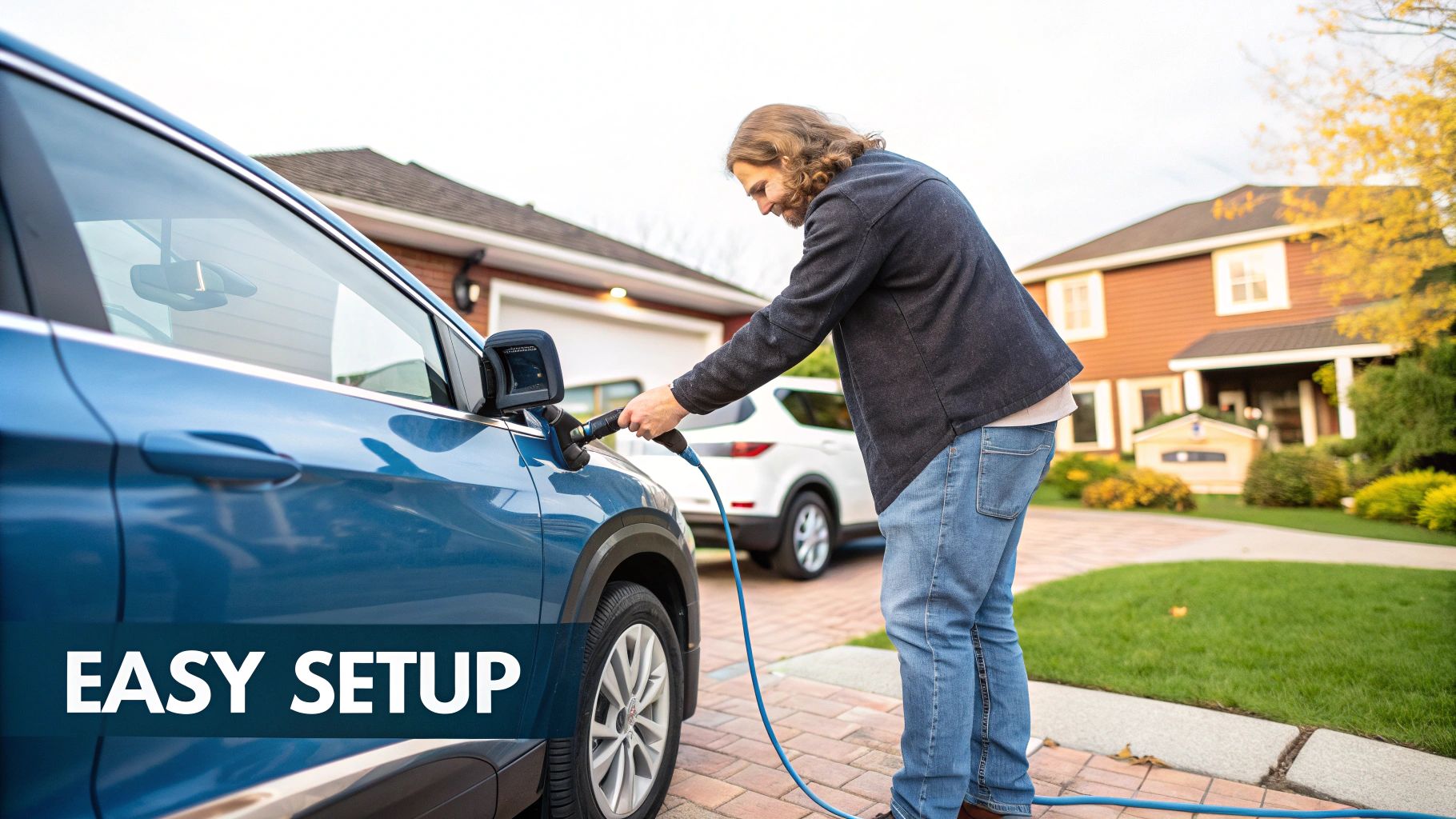
The Correct Connection Sequence
Think of the connection process as a polite handshake between the charger and your car, with the adapter working as interpreter. Get the order wrong and you risk communication hiccups or even electrical damage.
Follow these three steps every time:
- Connect Adapter to Charger First: Plug the adapter into the charging station’s cable and listen for a reassuring click.
- Plug into Your Vehicle: With the adapter secure on the cable, slot the whole assembly into your car’s port.
- Authorise and Start Charging: Use the station’s screen or app to initiate the session and let the current flow.
When you’re done, simply reverse that sequence: stop the session, unplug from your car, then detach the adapter from the cable.
Essential Safety Advice For Adapter Use
Neglecting basic care is a common cause of charging headaches. A few simple checks can make every session trouble-free.
• Keep It Dry:
Never charge in heavy rain or if connectors are damp. Store the adapter in a dry spot—your boot is ideal.
• Inspect Regularly:
Before each use, scan the casing for cracks and the pins for bends or damage.
• Never Exceed Power Limits:
Adapters are rated for a set maximum. Plugging into an over-powered charger risks overheating—and potentially fire.
An electric car charger adapter is a precision tool, not a blunt instrument. It’s designed to facilitate a complex digital conversation between the charger and your car, managing heat and power flow. Treating it with care ensures this conversation happens safely.
Troubleshooting Common Adapter Issues
Even the best routine can hit a snag when software or hardware refuses to talk. If the station fails to recognise your car, don’t panic.
First, perform a quick reset. Disconnect everything, count to 60, then reconnect in the proper order. This often clears minor handshake faults.
If that doesn’t work, try another charger nearby. Sometimes it’s the station, not your adapter. Finally, check every pin and port for dirt or debris—clean contacts are essential for a solid connection.
What’s Next for EV Charging and Adapters?
The world of electric vehicle charging is always on the move, with new tech and standards constantly changing how we power up. Right now, an electric car charger adapter is a must-have for navigating today's varied and sometimes confusing network. But looking down the road, the trend is clearly pointing towards a much simpler, more advanced future.
The industry is slowly but surely heading towards one main standard. Think of how USB-C became the go-to port for nearly all our gadgets; the Combined Charging System (CCS) is doing the same for new cars in the UK and Europe. Over time, this shift means the need for some adapters, especially for rapid charging, will fade as older standards like CHAdeMO are gradually phased out.
The Push Towards a Single Standard
This move towards uniformity is fantastic news for drivers. A single, dominant standard makes public charging far less of a headache, taking away a major hurdle for anyone thinking of switching to an EV. As the network matures, owners of new cars will find they rarely need to reach for an adapter on their daily trips.
You can see this happening in the rapid growth of the UK's charging network. The market is booming, with the number of public chargers projected to jump from around 50,640 in 2024 to a massive 169,150 by 2030. This expansion, driven by a compound annual growth rate of 21.32% , is almost entirely focused on installing modern, compatible chargers. You can dive deeper into the growth of the UK's EV charging market here.
Beyond the Plug: What’s on the Horizon?
While physical plugs are becoming more standardised, the real excitement lies in technologies that could get rid of them completely. Two key developments are set to change how we think about topping up our cars.
- Wireless Inductive Charging: Imagine just parking your EV over a special pad and having it start charging automatically. No cables, no fumbling with plugs. This tech uses magnetic fields to send power to your car, offering the ultimate convenience for both home and public spaces.
- Vehicle-to-Grid (V2G) Systems: V2G technology turns your car into a two-way street for energy. It not only draws power from the grid but can also send it back. This could transform EVs into mobile power banks, helping to stabilise the grid during peak hours and potentially even earning you money.
While the future promises a world with fewer cables and smarter charging, we’re still in a transition period. For the foreseeable future, a good understanding of adapters remains a vital skill for every EV driver trying to make sense of today’s mixed-standard environment.
These advancements point to an exciting future, but a full switch will take years. Until then, the humble electric car charger adapter will remain a key part of every EV driver's kit, ensuring you can plug in and power up, no matter where you are.
Still Have Questions?

Stepping into the world of EV charging can feel a bit like learning a new language. Let's tackle some of the most common queries about electric car charger adapters so you can plug in with total confidence.
Do I Really Need an EV Charger Adapter in the UK?
For many drivers, the answer is a firm yes but it really boils down to your specific car and how you use it. If you’ve got a newer EV with a CCS port and you tend to stick to the big, modern rapid-charging networks, you might find you rarely need one.
But what if you own an older Nissan Leaf with a CHAdeMO port, or your travels take you to more remote areas with a patchwork of different charging providers? That’s where an adapter becomes your best friend. It’s the ultimate safety net, ensuring you’re never stranded just because of an incompatible plug.
Are Third-Party Charger Adapters Safe?
This is a big one, and rightly so. When you are dealing with high-voltage charging, safety is everything. While plenty of third-party adapters are perfectly fine, you have to be wary of the cheap, uncertified ones floating around online. Always check for the right safety marks.
Crucially, you should only ever buy an electric car charger adapter that has a CE mark. This little symbol is your guarantee that the product meets UK and European standards for health, safety, and environmental protection. Using uncertified gear is a huge gamble—it could damage your car's battery or charging port, landing you with a very expensive repair bill.
Can an Adapter Slow Down My Charging Speed?
It certainly can but only if the adapter's power rating is lower than what the charger is putting out. Think of it like a bottleneck. Every adapter is rated for a maximum power level (measured in kilowatts, or kW ) that it can handle safely.
For example, if you pull up to a 150kW ultra-rapid charger but use an adapter only rated for 50kW , the whole system will automatically throttle the power down to that 50kW limit. To make sure you’re always getting the fastest charge possible, invest in an adapter with a rating that matches or, even better, exceeds the speed of the chargers you plan to use.
If you're looking for a charging solution that skips the public infrastructure headache altogether, ZAPME offers powerful and flexible mobile options to get your EV powered up, wherever you are. Find out more about our services at https://www.zapme.biz.

